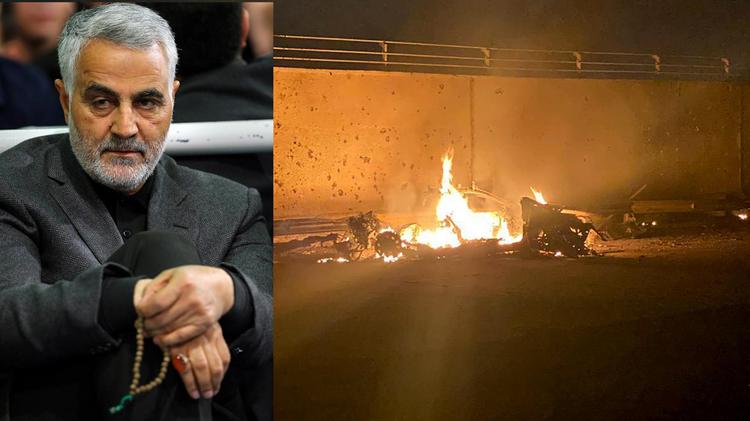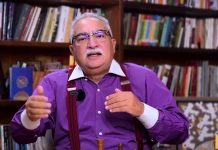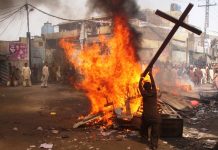Analysis/The Four Critical Questions After the Assassination of Iran’s Soleimani
Anshel Pfeffer/Haaretz/January 04/2020
انشيل فايفر/هآرتس: الأسئلة الأربعة الحرجة بعد اغتيال قاسم سليماني
It’s impossible to exaggerate the repercussions of this event, and even Trump’s most steadfast supporters should be regretting the absence of a seasoned national-security staff around him
The United States just took out the most important symbol of Iranian power and its most effective operational tool in the region. It’s impossible to exaggerate the influence wielded by Qassem Soleimani in the 22 years he commanded the Iranian Revolutionary Guards’ Quds Force.
There was the power he had over governments and fighting forces across the region and his ability to shape events – from his physical presence on the front lines, which over the years took on an almost mythic quality, to his quiet diplomacy, coupled always with intimidation and bribery behind the scenes. His loss to the Iranian Islamic revolutionary regime, especially to Supreme Leader Ali Khamenei, is a crushing blow, and on an operational and intelligence-gathering level, a major coup for the Trump administration.
For many countries across the Middle East, especially in Syria and Iraq, where Soleimani was directly responsible for spreading so much death and destruction, as well as for Iranian dissidents, it will be a moment for grim satisfaction, even jubilation. Iran will have no choice but to retaliate with massive force and try to extract painful retribution from the United States and its allies in the region.
This is the most fateful action by the Trump administration in the Middle East in the past three years – the blatant assassination of effectively the second-most powerful man in his country and over the past two decades the most powerful in the region.
It’s impossible to exaggerate the repercussions of this event, and even Donald Trump’s most steadfast supporters should be regretting the absence of a seasoned national-security staff around him, capable of challenging his decisions and assumptions. For the past 22 years, Soleimani was a constant if bitter foe; without him, matters become a lot less predictable.
There are now two critical questions to ask of Iran and two of the United States.
Will Iran abandon its caution?
Ever since it was forced to accept a humiliating stalemate at the end of its bloody war with Iraq in the ‘80s, the Iranian leadership has refrained from meeting its adversaries head on, instead developing asymmetrical warfare and proxy management to an art.
The million-plus deaths in the Iran-Iraq War and the recognition that Iran lacked the firepower and resources to fight another direct war were the constant factors in Soleimani’s grand strategy. Now both his absence from the leadership discussions and the enormous anger at his assassination may affect Iran’s innate caution.
There are a range of targets for Iran to strike back at. U.S. forces in the region, Western oil tankers in the Gulf, America’s main allies – the Saudis and Israel. And does Iran now strike, as usual, using proxies like the Yemeni Houthis and Hezbollah? Or does avenging Soleimani necessitate his own Quds force spearheading the counterattack?
Whatever the course of action, Iran will need to be able to contain the escalation to ensure it can prevent a spillover into its own territory, at it has largely achieved since the end of the Iran-Iraq War. But the man in charge of that strategy is no longer there.
How will Soleimani’s loss affect Iranian power?
It’s no coincidence that Soleimani held on as Quds force commander for 22 years and was mentioned even as a possible heir to the supreme leader (though that was almost certainly an exaggeration). No one could hold in his hand all the loose strands of the shifting regional power play and manipulate them like puppet strings as he did.
Soleimani played the key role in destabilizing Iraq after the American invasion. He transformed Hezbollah from a medium-sized militia into an army-sized force and the main power broker in Lebanon. And then came his greatest achievement, at the cost of hundreds of thousands of deaths: Without him Bashar Assad would not have remained president of Syria in his Damascus palace – even if Soleimani had his share of failures as well.
He had trusted, able and experienced lieutenants, but none have his range of contacts across the Middle East and beyond, and more crucially, none inspire anything near the respect and fear that just the mention of “Haji Qassem” had in cabinet rooms and command centers in half a dozen countries.
His loss will have an effect within the Tehran power structure as well. Soleimani’s power was such that despite the setbacks in Syria in the last three years, when Israel stymied many of Soleimani’s plans to establish long-term military bases there, and as both the faction around President Hassan Rohani and protesters on Iran’s streets called for investing resources at home instead of exporting the Islamic revolution abroad, Khamenei continued to support Soleimani.
Without Soleimani to lead the campaign, Iran could now, for once, drastically misjudge its response and lead to an all-out war. But if the fallout is contained, there is the hope that without Soleimani, Iran could start curbing its regional aspirations.
What was Trump trying to achieve?
After a year of what seemed like dithering on the Iranian front, Trump appealed for a high-level meeting with Rohani and was rebuffed. He failed to respond to attacks on shipping in the Gulf, to the shooting down of an American drone and to missiles launched at Saudi oil installations.
And most crucially perhaps, after a year when Trump almost gave Iran the most glittering prize in the shape of a withdrawal of U.S. troops from Syria, he has suddenly pivoted 180 degrees to a full-on confrontation, with airstrikes on Iranian-backed militias in Iraq, the immediate deployment of combat troops and now the assassination of Soleimani.
Ostensibly, the reason for the airstrikes was the death of an American citizen in an attack by Iranian-backed militias in northern Iraq, and the killing of Soleimani was part of a wider move to prevent further attacks on American personnel and bases. And yet, killing a figure like Soleimani is a strategic move. Did Trump have a broader objective or was the temptation to exploit an opportunity to take out such a prominent figure, someone even Trump would have been acquainted with from his very short daily intelligence briefings, simply too great?
The United States has had similar opportunities to strike Soleimani in the past. But the potential backlash was judged as too great. Besides, at various points over the past two decades, the United States had indirectly cooperated with him in the hope that this could stabilize Iraq and help fight Al-Qaida and the Islamic State.
Whether Trump gave the order this time on an impulse, as part of a wider campaign against Iran, and who knows, in the hopes that it could boost his prospects entering the election year, will have a major effect on what comes next.
Does anyone in the administration have a plan?
Four months ago, Trump still had a team of dedicated Iran hawks in the National Security Council. But John Bolton is gone, an implacable enemy, and Trump has publicly repudiated Bolton’s visions of regime change in Iran. That may well be a good thing, but with the hollowing out of the NSC and the upper echelons of the State Department, there’s barely a skeleton of a professional staff of advisers around Trump, but instead a group of sycophantic hangers on. He still has the largest, most professional and best-equipped armed forces and intelligence community in the world, but no one really in charge of strategic thinking.
Trump could be blundering into a ferocious war with Iran without a plan. And even if he doesn’t go to war, extricating the United States from this escalation could inflict damage both on America’s interests and on its allies. The U.S. is a thousand times more powerful, but Iran, since the revolution of 1979, has proved itself more than capable of exploiting every moment of hesitation, every misjudgment and every temporary vacuum provided by U.S. administrations.
And these are uncharted waters whose direction no one can predict. A venal and vainglorious president in the White House and an Iranian leadership that has just lost its wisest member – both fighting for survival at home – are now facing off while standing on the brink.






















